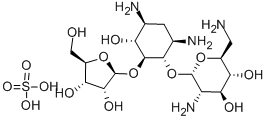Description
Ribostamycin was found in the culture broth of Streptomyces ribosidificus by Meiji Seika Kaisha in 1970 in the course of screening aminoglycoside antibiotics. It is structurally related to neomycin but lacks the diaminoidose (glucose) moiety substituted on the ribose moiety. Ribostamycin is much less toxic than neomycin and shows strong activity against a variety of gram-positive and gram-negative bacteria, except Pseudomonas aeruginosa. It is used parenterally for therapy of urinary tract, respiratory tract, surgical, and other infections.
Definition
ChEBI: An amino cyclitol glycoside that is 4,6-diaminocyclohexane-1,2,3-triol having a 2,6-diamino-2,6-dideoxy-alpha-D-glucosyl residue attached at position 1 and a beta-D-ribosyl residue attache
at position 2. It is an antibiotic produced by Streptomyces ribosidificus (formerly S. thermoflavus).
Mechanism of action
Ribostamycin (SF-733) is produced by
Streptomyces ribosidificus. The free base is crystallized
from methanol solution. The structure
has been determined by chemical methods and
total synthesis has been undertaken .
